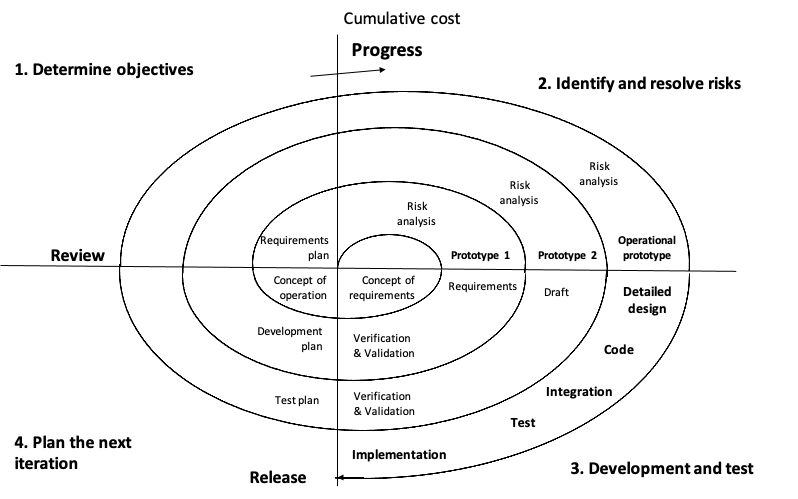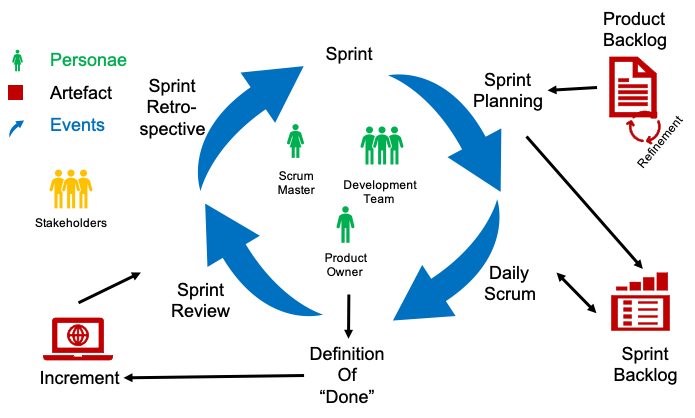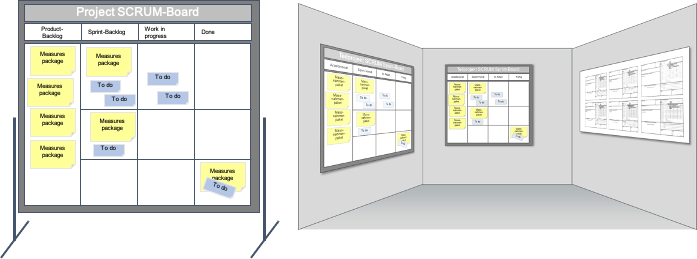PM Tools like Customer Product Management (CPM) are and will remain the
leading methods for the organizational regulation of demand determination,
coverage and use in the public sector. However, a process supplemented by agile
methods, in this case Scrum, can support these management tools effectively and
efficiently. Especially in the implementation phase, Scrum is thus also suitable
for "non-software development projects" to meet the demands for a transparent
and more efficient public goods management. In addition to agile methods in PM,
the use of agile requirements management is also conceivable within the
Integrated Planning Process (IPP).
Advantages of agile methods considering spiral
development

The
Spiral Model or "Boehm Spiral Model" goes back to two publications by Barry
Boehm (Boehm, Barry: A Spiral Model of Software Development and Enhancement) and
describes as one of the first process models the so-called iterative-incremental
development process of software. It is visualized by a spiral, which, starting
from the origin of a rectangular coordinate system in clockwise direction,
encloses an ever increasing area. Each revolution corresponds to the passing
through of a development cycle in the phases of the waterfall model:
1.
Clarification of objectives, survey of requirements, determination of boundary
conditions
2. Risk analysis, design, creation of prototypes
3.
Implementation, user test
4. Evaluation of the iteration, planning next
iteration or stopping the project.
Typical for the spiral model is the strong
emphasis on risk analysis, which should prevent a failure of the project at an
early stage or stop a hopeless project as soon as possible. This is especially
important for long-term projects, as the requirements and conditions can change
frequently.
With agile methods such as Scrum and Kanban, in which a large
project is broken down into smaller ones and projects run cyclically, errors can
be avoided and processes can be made more structured and efficient.
Scrum is
used as an agile method (Fig. 2) with the focus on achieving defined results
(increments).

Figure 2 Scrum circle
Scrum consists of a few rules, described by:
-
Events: Sprint Planning, Daily Scrum, Sprint Review, Sprint Retrospective
-
Artefacts: product backlog, sprint backlog, increment (product to be
released)
- Personae: Product Owner, Scrum Master (replaces Project Manager),
Scrum Team.
The goal is a fast and resource-saving development of
high-quality (digital) products. The Scrum board (Fig. 3) has proven to be a
useful tool in the actual project work.

Kanban, originally a method for the flexible control of production processes
by visualization, is shown in many application development projects as a Kanban
board (Fig. 4), in its simplest form with the categories "To Do", "Doing" and
"Done" for the tasks to be performed.
The goal of using Kanban in a team is
also here the structuring of tasks through regular meetings, status comparison,
avoidance of multitasking and naming of obstacles in order to achieve an
effective and efficient utilization of the team.
Limits from the perspective of project management such a
procedure
As a basic assumption in software development one assumes
that there is never a finished product. There is a continuous development
through iterations / versions. The spiral model illustrates this very clearly
and Scrum gives project management an adequate method. To successfully apply
this method there is the so-called sprint boundary, an impermeable boundary from
the outside to the inside; but also from the inside to the outside. It ensures:
once the sprint goal is defined, it is not changed by "great new ideas" from
outside. Once the sprint is started, the boundaries (sprint backlog, sprint
goal) are valid until the time box of this sprint is completed or the sprint is
aborted (in rare cases). This is an essential success factor of Scrum, the team
can work in a concentrated manner.
These limits also set clear goals. The
goals in the sprint backlog and a sprint goal limit the team's room for
manoeuvre very exact and with the help of user stories also very clearly! Of
course, sprint limits do not mean a limit or limitation of communication, this
is rather promoted by working tools like scrum board and Kanban project control
centre. The boundaries help to focus on the tasks of the sprint.
As essential
and necessary boundaries/interfaces of the method, the lived Definition of Done,
Acceptance Criteria and regular Retrospectives are mentioned. These often go
further than non-lived specifications and unrealistic targets, which are the
practice in some classical plan-driven contexts. So in many respects it is not
the boundlessness but the limits that make agile methods like Scrum successful.
This is not only true for Scrum, but also for Kanban, XP, Design Thinking
and other agile approaches - be it in the form of agreed processes, time boxes,
roles, goals, purpose, etc.
Essentially these limits are:
- easy to understand and clear,
- clear
and with comprehensible meaning,
- binding and are lived,
- only regulate
what is necessary - no micromanagement, no unnecessary "how" specifications, but
specifications for the "what" and a common understanding of the "why”
- and
the limits are often developed further together,
to work towards the goal in
a concentrated and focused manner.
This is what distinguishes agile methods
from the common practice in the classical project management context. There, it
is rather specifications that shape the management and define how to work.
Specifications regulate the "how" of the service provision. In contrast to
agile, where the "what" and the "why" are worked out and drawn as boundaries,
while the team determines the "how" itself.
Necessary concrete prerequisites
for the application of agile methods in multinational programs
As essential
prerequisites for success, the following rules should be agreed upon, in
addition to the availability of experts:
- Regular (e.g. weekly/daily) joint
work and review meetings,
- Workshop atmosphere, 4-5 hours duration,
-
Participants are the experts from the respective fields,
- Control of
activities via Scrum methodology and Scrum boards,
- A project room for work
and workshops as a "Kanban Control Centre", where essential results as well as
Scrum boards are permanently visible and maintained.
Working with agile methods is no guarantee for success. Experience shows that
the attitude of team members and managers is of crucial importance.
After
all it is not the methods that matter, but the people.
Munich November 2020
Contemporary Management Issues


